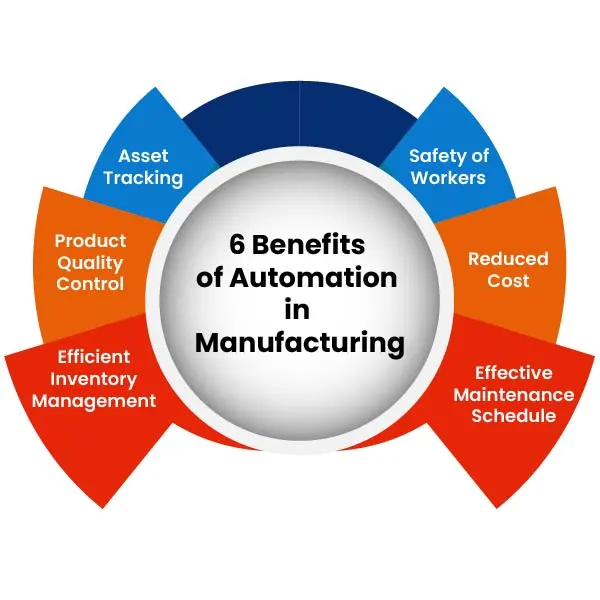From improved maintenance to reduced cost and better safety, automation has a lot to offer to the manufacturing industry. With the advancement in technology, manufacturing companies all around the globe are using automation tools and techniques to streamline their processes and enhance workforce productivity. Minimal or no human participation is required in automated manufacturing processes that can autonomously perform the operations of handling materials, inspection, processing and assembling.
Currently, automation in manufacturing companies is complemented by the Internet of Things (IoT) which has now become a global technology to revolutionize a wide range of industrial procedures. Process automation in manufacturing incorporates IoT devices or a network of sensors to gather the important production data, store data in the cloud and use analytics techniques to transform this data into valuable insight. Hence, it can be said that the IoT has made automation in the manufacturing process a lot easier, but from a business point of view, the benefits of automation in manufacturing due to the use of IoT have remained unclear.
The following article discusses the top 6 benefits of automation in manufacturing and how IoT is helping the manufacturing sector in achieving those benefits.
1. Product Quality Control
Checking the quality of the manufactured product before it reaches the target audience is the most important responsibility of the manufacturing industries. Without automation in quality control, human labourers are employed to manually check the flaws in the product. Through automation, top quality products are distributed in the market. IoT makes the quality control process highly proactive and automated. With the help of video and thermal sensors, the quality of the product is checked at each stage of the product life cycle and the process is completed without any human interaction. Environmental conditions (humidity, temperature), machine conditions (vibration, speed, etc.) and equipment calibration are the main parameters to monitor the quality of the automated product manufacturing process. For instance, if the reading of the IoT sensor is reaching the threshold that can result in a potential product defect, then the automated quality monitoring system generates alerts while identifying the source of the issue. The system enables the manufacturers to take appropriate actions to fix the quality error and reduce the production of low-quality products.
2. Efficient Inventory Management
Inventory management processes in the manufacturing industries nowadays are found to be highly automated. However, efficient inventory management is not possible without integrating IoT devices in manufacturing procedures. In this regard, Radio Frequency Identification (RFID) makes inventory management a seamless and efficient process. In such procedures, the RFID tag is attached with every item in the inventory which in turn is comprised of a Unique Identification Number (UID) which have digital information about the product. The role of IoT in this regard is to convert the data collected through RFID sensors into valuable information. For instance, as per the data collected on the inventory location and quantity, the automated inventory management architecture can be utilized to calculate the type and quantity of the raw materials required for completing the product life cycle. This ultimately reduces product waste and cost. With the help of IoT, supply chain managers have given complete transparency about the work-in-progress, arrival of raw materials and realistic estimates of the available material etc. This in turn improves product handling time and ensure efficient processing of materials for production.
3. Effective Maintenance Schedule
Usually, manufacturers employ time-based practices and approaches for developing a maintenance schedule for equipment and machinery. However, the study conducted by the ARC group revealed that 18% of the time, the reason behind the equipment failure is an account of age, whereas, the remaining 82% of equipment failures are random. Hence, it can be said that the time-based approach for maintenance schedule is neither cost-effective nor efficient. Referring to this, manufacturing companies can use automation, data science and industrial IoT for predictive maintenance and can avoid ineffective maintenance routines. IoT sensors can be attached to the equipment to keep the track of the operating environment to determine the need for maintenance. Prompt repair and equipment services can make the maintenance process more efficient, can result in substantial cost-saving, avoidance of downtime and easy allocation of the work to the field technicians. This predictive maintenance modelling can facilitate the managers to easily identify the discrepancies in the system and conduct a root cause analysis to prevent delays in production and machine failure. Hence, it can be said that the IoT does not only automate manufacturing but also help in maintaining heavy equipment for a long time.
4. Safety of Workers
In the manufacturing sector, the safety of the workers is highly prioritized. Automation helps manufacturers to retain high safety standards for their workers by using machines to perform dangerous work instead of humans. This manufacturing automation combines IoT and data analytics to ensure workers’ safety. The fusion of the aforementioned technologies uses to track various KPIs, for instance, machinery damage, presence of hazardous material, vehicle mishap or worker absence which can impact the well-being of the workers and normal activities. Automation and IoT wearable are the ultimate solution to workers’ safety. With the help of such devices, the health of the workers can be monitored continuously. For instance, instead of manually identifying the hazards, IoT automation tools can be used to determine the worker’s exposure to harmful fumes, fatigue, heart rate, stress level and things in the surrounding which can damage the workers’ health. The information gathered by these devices can be utilized by the business owners to improve the working environment for the workers and ultimately reduce insurance costs. Hence, automation in manufacturing processes with the help of IoT devices can prevent workplace injuries as well as the risk of accidents at the workplace, this, in turn, helps the manufacturers in building up a safe working environment.
5. Asset Tracking
The automation and use of IoT in the manufacturing sector not only improves the effectiveness of the manufacturing activities but also help in managing and tracking the assets effectively. In the time before automation, asset management was done manually which was a hectic and costly procedure. Automation through IoT in manufacturing ensures reliability, extended equipment service life, proper asset usage and best returns on assets. The automatic asset tracking system incorporates a wide range of network sensors to keep the record of commonly used tools and assets. The sensors capture the timeline of events, enabling the manufacturers to track inventory and assets in real-time. This ultimately increases the manufacturing efficiency and reduces the manual efforts of the workers to track the manufacturing assets. Along with this automated asset tracking system, the movable asset can also be tracked with the help of GPS tracking covering a wide range of areas and even cities. In this regard, the utilization of the movable assets is also monitored for determining the timeframe in which a particular asset is in use. This helps the manufacturers and technical personnel to schedule preventive maintenance by pinpointing underused and idle machines.
6. Reduced Cost
Nowadays, manufacturing companies are focusing on automating and streamlining the complex manufacturing process with the help of IoT as it holds the potential to maximize profits and enable the companies to save money instead of wasting them on manual processes. By automating the manufacturing process, the operational cost can be saved in the long run. Automation is decreasing 70% of the breakdowns and facilitating the manufacturers in saving up to 12% on equipment repairs. It does not only reduce the equipment cost but cut off the labor cost as well. IoT-based automation in manufacturing helps in reducing the overall operational cost of the company by offering predictive maintenance and the ability to implement effective measures.
Future Prospects of IoT in Process Automation in Manufacturing
Manufacturing industries are moving towards automation and task which requires hundreds of workers to complete are now done within seconds with the help of automated machines and IoT networks. IoT-based automation has a significant positive impact on manufacturing procedures. Nearly, USD 214 billion revenue has been generated by the automation industry in 2021, and alone industrial automation accounts for USD 83 billion globally. However, the automation of the manufacturing activities cannot be done without the use of IoT devices, hence, it can be said that both the automation and IoT industries are evolving simultaneously and have considerable growth in the future.
Conclusion
In conclusion, it can be summarized that the benefits of automating the manufacturing operations are limitless, however, in this regard, IoT has a substantial contribution to make. This is because the majority of the automated actions are taken based on the data generated from the sensors and smart devices. Undoubtedly, automation enables the manufacturers to utilize the benefits of product quality, inventory management, maintenance schedule, asset tracking, enhanced safety of the workers and reduced overall operational cost. These benefits are achieved when automation and IoT go hand in hand with each other to evolve the manufacturing industries.





